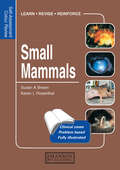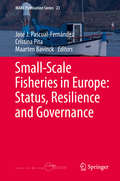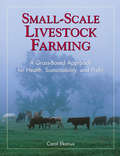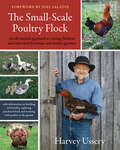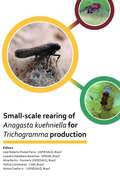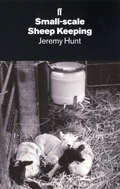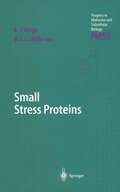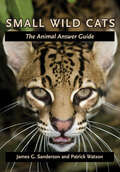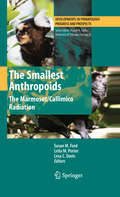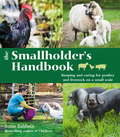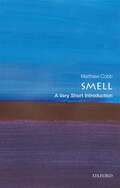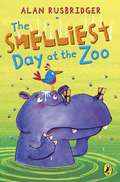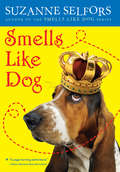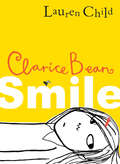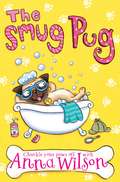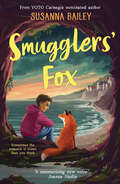- Table View
- List View
Small Mammals: Self-Assessment Color Review
by Susan A. Brown Karen L. RosenthalVeterinary practitioners are faced regularly by diseases and disorders in a large and ever increasing range of small mammalian patients. The Editors have gathered together contributions from 29 experts, who cover all aspects of medicine and surgery in small mammals including rabbits, guinea pigs, rodents, hedgehogs, ferrets, primates, squirrels, fo
Small-Scale Fisheries in Europe: Status, Resilience and Governance (MARE Publication Series #23)
by José J. Pascual-Fernández Cristina Pita Maarten BavinckThis book offers a comprehensive account of the status and dynamics of people participating in the small-scale fisheries (SSF) of Europe. It covers the situation of SSF in 25 coastal countries, thereby providing a portrait of almost every coastal country on the continent and analyzing the recent evolution of the sector. Small-scale fisheries are argued to be extremely important in Europe, as they provide employment and welfare, while increasing food sovereignty and maintaining communities in coastal areas. The recent worldwide focus on SSF derives from their environmental sustainability, which distinguishes many of their activities from those of large-scale fisheries. This book analyses the diversity of SSF and shows how fishing communities have sometimes developed successful governing models, demonstrating social and economic resilience. While the book emphasizes the strengths of SSF and the synergies that occur with other marine sectors, it also presents cases of failure, in which collective action and policy have actually contributed to a weakening of the sector. In this context, the book shows how governmental policies toward SSF vary considerably from country to country, in a way that is not entirely consistent with European policies.
Small-Scale Livestock Farming: A Grass-Based Approach for Health, Sustainability, and Profit
by Carol EkariusFull of practical everyday advice, this guide explains how a natural, organic approach to livestock farming produces healthy animals, reduces costs, and increases your operation&’s self-sufficiency. Livestock expert Carol Ekarius helps you create a viable farm plan, choose suitable livestock, care for your animals&’ health, and confidently manage housing, fencing, and feeding. Case studies of successful farmers provide inspiration as you learn everything you need to know to run a prosperous livestock farm and make the lifestyle of your dreams a reality. This publication conforms to the EPUB Accessibility specification at WCAG 2.0 Level AA.
The Small-Scale Poultry Flock: An All-Natural Approach to Raising Chickens and Other Fowl for Home and Market Growers
by Harvey Ussery Joel SalatinThe most comprehensive guide to date on raising all-natural poultry for the small-scale farmer, homesteader, and professional grower. The Small-Scale Poultry Flock offers a practical and integrative model for working with chickens and other domestic fowl, based entirely on natural systems. Readers will find information on growing (and sourcing) feed on a small scale, brooding (and breeding) at home, and using poultry as insect and weed managers in the garden and orchard. Ussery's model presents an entirely sustainable system that can be adapted and utilized in a variety of scales, and will prove invaluable for beginner homesteaders, growers looking to incorporate poultry into their farm, or poultry farmers seeking to close their loop. Ussery offers extensive information on: The definition of an integrated poultry flock (imitation of natural systems, integrating patterns, and closing the circle) Everything you need to know about your basic chicken (including distinctive points about anatomy and behavior that are critical to management) Extended information on poultry health and holistic health care, with a focus on prevention Planning your flock (flock size, choosing breeds, fowl useful for egg vs. meat production, sourcing stock) How to breed and brood the flock (including breeding for genetic conservation), including the most complete guide to working with broody hens available anywhere Making and mixing your own feed (with tips on equipment, storage, basic ingredients, technique, grinding and mixing) Providing more of the flock's feed from sources grown or self-foraged on the homestead or farm, including production of live protein feeds using earthworms and soldier grubs Using poultry to increase soil fertility, control crop damaging insects, and to make compost-including systems for pasturing and for tillage of cover crops and weeds Recipes for great egg and poultry dishes (including Ussery's famous chicken stock!) And one of the best step-by-step poultry butchering guides available, complete with extensive illustrative photos. No other book on raising poultry takes an entirely whole-systems approach, or discusses producing homegrown feed and breeding in such detail. This is a truly invaluable guide that will lead farmers and homesteaders into a new world of self-reliance and enjoyment.
Small-scale Rearing of Anagasta kuehniella for Trichogramma Production
by José Roberto Postali Parra Leandro Delalibera Geremias Aline Bertin Yelitza Colmenarez Aloisio Coelho Jr Jennifer Brown Janet R. ReidThis technical guide describes the techniques for small-scale rearing of the egg parasitoids Trichogramma spp. in the factitious host Anagasta kuehniella. These parasitoids are among the most widely used natural enemies in the world, and in Brazil are used to control lepidopteran pests in a wide variety of crops, including sugarcane, corn, soybean, cotton, vegetables (tomatoes, potatoes), fruit (avocado, citrus, grapes), and tobacco.
Small-Scale Sheep Keeping
by Jeremy HuntSmall-scale sheep keeping is one of the major growth areas of livestock breeding. The success of rare breeds and their proven commercial qualities has encouraged intense interest in minority sheep but whether you keep ten or a hundred ewes the same strict principles of management must be followed if success is to be achieved. This book aims to inform, encourage, advise and even entertain its readers. Sheep keeping can be a most enjoyable hobby but small flock owners all too often find it difficult to related to books aimed at the commercial producer. Sound, practical advice which is easily understood and efficiently put into practice is what this book offers.
Small Stress Proteins (Progress in Molecular and Subcellular Biology #28)
by A. P Arrigo W. E. G. MüllerSmall Wild Cats: The Animal Answer Guide (The Animal Answer Guides: Q&A for the Curious Naturalist)
by Patrick Watson James G. SandersonDid you know that most wild cat species are small and that lions, tigers, and other large cats are the exception? That adult bobcats, clouded leopards, and other small wild cats are completely asocial? And that they fight only as a last resort? This entertaining and informative book reveals these and hundreds of other facts about the behavior, biology, and conservation of the more than 30 small wild cat species. From bobcats to servals, small cats are spread across the globe. They range in size from the rusty-spotted cat and African black-footed cat, each of which weighs around 5 pounds when fully grown, to the Eurasian lynx, which can reach an adult weight of 60 pounds. These felids are elusive, some are nocturnal, others are arboreal, and all are rare and secretive, making them especially difficult to study. James G. Sanderson, the world’s leading field expert on small wild cats, and naturalist and wildlife artist Patrick Watson provide informative and entertaining answers to common and unexpected questions about these animals. The authors explain why some small cats live on the ground while others inhabit trees, discuss the form and function of their coat types and colors, offer scientifically sound information on human–small wild cat interactions, and even review the role that small wild cats have played in literature, religion, and mythology. The world of cats is as fascinating as it is diverse. Small Wild Cats: The Animal Answer Guide shows just how important and interesting the littlest of the nondomesticated feline family are.
The Smallest Anthropoids: The Marmoset/Callimico Radiation (Developments in Primatology: Progress and Prospects)
by Susan M. Ford Leila M. Porter Lesa C. DavisHere is a comprehensive examination of the newly recognized callimico/marmoset clade, which includes the smallest anthropoid primates on earth. It features sections on phylogeny, taxonomy and functional anatomy, behavioral ecology, and reproductive physiology.
The Smallholder's Handbook: Keeping And Caring For Poultry And Livestock On A Small Scale
by Suzie BaldwinThe Smallholder's Handbook is a detailed manual to start, plan and manage your own smallholding. Suzie explains the level of work involved, how much space you need and how to prepare your land. There are chapters on keeping poultry (chickens, turkeys, ducks and geese), as well as pigs, goats and sheep, cows and bees. She also explains why having a variety of animals makes the best use of your resources and how many of each type to keep. Comprehensive advice includes choosing breeds, transporting, feeding, housing, daily care and wellbeing, as well as international legislation that applies to livestock.
Smart Livestock Nutrition (Smart Animal Production #1)
by Ilias KyriazakisThis book highlights the latest findings and techniques related to nutrition and feed efficiency in animal agriculture. It addresses the key challenges facing the nutrition industry to achieve high animal productivity with minimal environmental impact. The concept of smart nutrition involves the use of smart technologies in the feeding and management of livestock.The first chapters focus on advances in biological fields such as molecular agriculture and genotype selection, as well as technologies that enhance or enable the collection of relevant information. The next section highlights applications of smart nutrition in a variety of livestock systems, ranging from intensive indoor housing of broilers and pigs to extensive outdoor housing of cattle and sheep, and marine fish farms. Finally, because of the worldwide attention to this issue, the authors address the environmental consequences.This work, which takes a serious look at how nutrition can be used to improve sustainability in animal agriculture, is a key literature for readers in animal and veterinary sciences, the food industry, sustainability research, and agricultural engineering.
The Smartest Animals on the Planet: Extraordinary tales of the natural world's cleverest creatures
by Sally BoysenWe have all heard talk of the intelligence of dolphins, elephants orgreat apes, or even, in different ways, ants and bees. But what is thisintelligence all about? How do we know which animals are smart, and howdo they use this superior intelligence?Written by one of the world's authorities in this field, this rivetingbook cover the themes of tool use, language, communication, imitationand social learning, numerical abilities, social cognition, emotion,self-recognition and awareness, drawing together the most recent andremarkable global research relating to almost every "smart" species. Fully illustrated, and including step-by-step illustrations to showexperiments and observations both in the field and in captivity,Covering the core themes of, this book delivers cutting-edge scientificresearch about a topic fascinating to anyone interested in the naturalworld.
Smell: A Very Short Introduction (Very Short Introductions)
by Matthew CobbOur sense of smell - or olfaction as it is technically known - is our most enigmatic sense. It can conjure up memories, taking us back to very specific places and emotions, whilst powerful smells can induce strong feelings of hunger or nausea. In the animal kingdom smell can be used to find food, a mate, or a home; to sense danger; and to send and receive complex messages with other members of a species. Yet despite its fundamental importance in our mental life and in the existence of all animals, our scientific understanding of how smell works is limited. In this Very Short Introduction, Matthew Cobb describes the latest scientific research on smell in humans and other mammals, in insects, and even in fish. He looks at how smell evolved, how animals use it to navigate and communicate, and disorders of smell in humans. Understanding smell, especially its neurobiology, has proved a big challenge, but olfactory science has revealed genetic factors that determine what we can and cannot smell, and why some people like a given smell while others find it unbearable. He ends by considering future treatments for smell disorders, and speculating on the role of smell in a world of robots. ABOUT THE SERIES: The Very Short Introductions series from Oxford University Press contains hundreds of titles in almost every subject area. These pocket-sized books are the perfect way to get ahead in a new subject quickly. Our expert authors combine facts, analysis, perspective, new ideas, and enthusiasm to make interesting and challenging topics highly readable.
Smell: A Very Short Introduction (Very Short Introductions)
by Matthew CobbOur sense of smell - or olfaction as it is technically known - is our most enigmatic sense. It can conjure up memories, taking us back to very specific places and emotions, whilst powerful smells can induce strong feelings of hunger or nausea. In the animal kingdom smell can be used to find food, a mate, or a home; to sense danger; and to send and receive complex messages with other members of a species. Yet despite its fundamental importance in our mental life and in the existence of all animals, our scientific understanding of how smell works is limited. In this Very Short Introduction, Matthew Cobb describes the latest scientific research on smell in humans and other mammals, in insects, and even in fish. He looks at how smell evolved, how animals use it to navigate and communicate, and disorders of smell in humans. Understanding smell, especially its neurobiology, has proved a big challenge, but olfactory science has revealed genetic factors that determine what we can and cannot smell, and why some people like a given smell while others find it unbearable. He ends by considering future treatments for smell disorders, and speculating on the role of smell in a world of robots. ABOUT THE SERIES: The Very Short Introductions series from Oxford University Press contains hundreds of titles in almost every subject area. These pocket-sized books are the perfect way to get ahead in a new subject quickly. Our expert authors combine facts, analysis, perspective, new ideas, and enthusiasm to make interesting and challenging topics highly readable.
The Smelliest Day at the Zoo
by Alan RusbridgerSlap bang in the middle of the hottest day of the year, the zoo’s drains have blocked up and there’s nowhere for the animals' poo to go! Mr Pickles the zoo keeper (who is looking distinctly green) must decide what to do with it all . . . Before the naughty chimps beat him to it!
Smells Like Dog (Smells Like Dog Ser. #1)
by Suzanne SelforsMeet Homer Pudding, an ordinary farm boy who's got big dreams-to follow in the footsteps of his famous treasure-hunting uncle. But when Uncle Drake mysteriously disappears, Homer inherits two things: a lazy, droopy dog with no sense of smell, and a mystery.Why would his uncle call this clumsy dog his "most treasured possession?" And why did he put a gold coin on the dog's collar?And who will continue Uncle Drake's quest-to find the most coveted pirate treasure in the world?Join Homer, his sister Gwendolyn, and Dog on an adventure that will test their wits and courage as they leave their peaceful farm and head into a world where ruthless treasure hunters hide around every corner. Where they discover that Dog has a hidden talent and that treasure might be closer than they ever imagined...
Smelly Louie
by Catherine RaynerLouie the dog has just had a bath - and he is NOT happy about it. He smells all wrong. Determined to get his Special Smell back, he goes on a hunt for it and meets lots of smelly things along the way - a fox, some interesting dustbins and a marvellously muddy puddle to roll in. Will he ever get his smell back? And, more importantly, will he be able to keep it this time . . . ?Catherine Rayner is the Kate Greenaway Medal-winning creator of Solomon Crocodile and Ernest. Smelly Louie is full of her trademark humour and richly textured artwork. Shortlisted for the Greenaway medal, this funny canine tale will be a sure-fire hit with children and adults alike.
Smile (Clarice Bean)
by Lauren ChildClarice Bean is back with all her trademark humour in this heartwarming story by former Children’s Laureate Lauren Child
Smilodon: The Iconic Sabertooth
by Lars Werdelin H. G. McDonald Christopher A. ShawFew animals spark the imagination as much as the sabertooth cat Smilodon. With their incredibly long canines, which hung like fangs past their jaws, these ferocious predators were first encountered by humans when our species entered the Americas. We can only imagine what ice age humans felt when they were confronted by a wild cat larger than a Siberian tiger.Because Smilodon skeletons are perennial favorites with museum visitors, researchers have devoted themselves to learning as much as possible about the lives of these massive cats. This volume, edited by celebrated academics, brings together a team of experts to provide a comprehensive and contemporary view of all that is known about Smilodon. The result is a detailed scientific work that will be invaluable to paleontologists, mammalogists, and serious amateur sabertooth devotees. The book ;€¢ covers all major aspects of the animal's natural history, evolution, phylogenetic relationships, anatomy, biomechanics, and ecology ;€¢ traces all three Smilodon species across both North and South America;€¢ brings together original, unpublished research with historical accounts of Smilodon's discovery in nineteenth-century BrazilThe definitive reference on these iconic Pleistocene mammals, Smilodon will be cited by researchers for decades to come. Contributors: John P. Babiarz, Wendy J. Binder, Charles S. Churcher, Larisa R. G. DeSantis, Robert S. Feranec, Therese Flink, James L. Knight, Margaret E. Lewis, Larry D. Martin, H. Gregory McDonald, Julie A. Meachen, William C. H. Parr, Ashley R. Reynolds. Kevin L. Seymour, Christopher A. Shaw, C. S. Ware, Lars Werdelin, H. Todd Wheeler, Stephen Wroe, M. Aleksander Wysocki
Smilodon: The Iconic Sabertooth
by Lars Werdelin H. G. McDonald Christopher A. ShawFew animals spark the imagination as much as the sabertooth cat Smilodon. With their incredibly long canines, which hung like fangs past their jaws, these ferocious predators were first encountered by humans when our species entered the Americas. We can only imagine what ice age humans felt when they were confronted by a wild cat larger than a Siberian tiger.Because Smilodon skeletons are perennial favorites with museum visitors, researchers have devoted themselves to learning as much as possible about the lives of these massive cats. This volume, edited by celebrated academics, brings together a team of experts to provide a comprehensive and contemporary view of all that is known about Smilodon. The result is a detailed scientific work that will be invaluable to paleontologists, mammalogists, and serious amateur sabertooth devotees. The book ;€¢ covers all major aspects of the animal's natural history, evolution, phylogenetic relationships, anatomy, biomechanics, and ecology ;€¢ traces all three Smilodon species across both North and South America;€¢ brings together original, unpublished research with historical accounts of Smilodon's discovery in nineteenth-century BrazilThe definitive reference on these iconic Pleistocene mammals, Smilodon will be cited by researchers for decades to come. Contributors: John P. Babiarz, Wendy J. Binder, Charles S. Churcher, Larisa R. G. DeSantis, Robert S. Feranec, Therese Flink, James L. Knight, Margaret E. Lewis, Larry D. Martin, H. Gregory McDonald, Julie A. Meachen, William C. H. Parr, Ashley R. Reynolds. Kevin L. Seymour, Christopher A. Shaw, C. S. Ware, Lars Werdelin, H. Todd Wheeler, Stephen Wroe, M. Aleksander Wysocki
Smiths’ Sea Fishes
by Margaret M. Smith Phillip C. HeemstraDr. D. S. Henderson, Chairman of the 1. L. B. Smith Institute of Ichthyology and Vice Chancellor of Rhodes University This book is a unique, international collaborative effort ranging all of the colour plates for the book. For the past of 76 scientists, representing 15 countries. Several skilled eight years, she has been assisted in the research, writing artists and photographers have also contributed to the and editing of the book by Dr. P. C. Heemstra. numerous and beautiful illustrations. Research done in It is essential for the proper management of the marine South Africa was supported by the Council for Scientific fish resources of southern Africa that we know what species and Industrial Research. Work on the book at the J.L.B. we are dealing with. This book will greatly facilitate the Smith Institute was also funded by the Department of identification of our fishes. It will thus be of vital import National Education and The Trustees of the Sea Fishes of ance to the understanding and wise use of our tremendously Southern Africa Book Fund. Expenses of visits by ichthy diverse and valuable fish fauna. ologists from overseas were defrayed by a grant from the We are proud of the affiliation of the J.L.B. Smith Insti John S. Schlesinger Foundation. tute with Rhodes University and happy to see the successful Although this book is an impressive contribution to the completion of this long-awaited work.
The Smug Pug (Pooch Parlour #3)
by Anna WilsonThere's a new kid in Crumbly-under-Edge. Smug the pug is clever, funny and full of surprises. And his owner, Tallulah Foghorn, is just as fantastic. PIppa Peppercorn has fallen head over heels for the devastating duo. Dash the dachshund, on the other paw, is not sure. He thinks Smug lives up to his name, and Tallulah is nuttier than one of Mrs Fudge's fruitcakes...
Smugglers’ Fox
by Susanna BaileyA spellbinding and poignant new adventure from Susanna Bailey, the critically acclaimed author of Snow Foal. Perfect for fans of Jacqueline Wilson and Hannah Gold
Snail (Large Print)
by RnibThis is a picture of a garden snail seen from the side and facing to the left. There is a locator dot shown, which will be at the top left of the page when the image is the right way up. Just down the page, there is a silhouette of the snail at approximately real size. On the left of the page is the snail's head, which has a small mouth and two long stalks with eyes at the ends. To the right is the body of the snail. Up the page from this is its shell. This grows in the form of a spiral; you can follow this round, starting from right of the head, to the centre of the shell. At the very bottom of the image is a trail of mucus (slime), which has been left by the snail. It is used to help it to slide easily over rough surfaces.
Snail (UEB Contracted)
by RnibThis is a picture of a garden snail seen from the side and facing to the left. There is a locator dot shown, which will be at the top left of the page when the image is the right way up. Just down the page, there is a silhouette of the snail at approximately real size. On the left of the page is the snail's head, which has a small mouth and two long stalks with eyes at the ends. To the right is the body of the snail. Up the page from this is its shell. This grows in the form of a spiral; you can follow this round, starting from right of the head, to the centre of the shell. At the very bottom of the image is a trail of mucus (slime), which has been left by the snail. It is used to help it to slide easily over rough surfaces.
